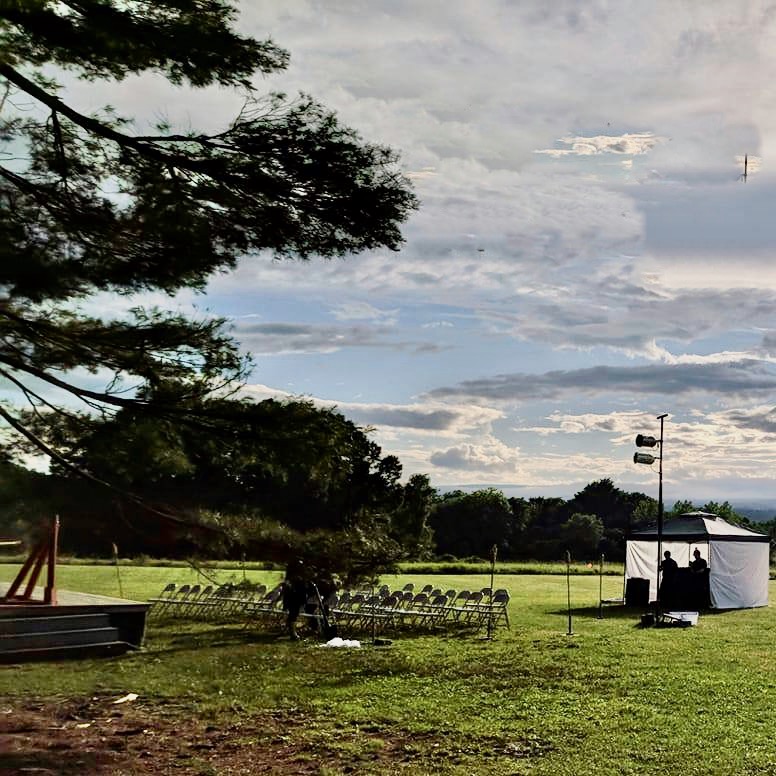Opinion: Putting Aesthetics Into The Conversation About The Pavillion And “Surplus” Property

Seating area for Hampshire Shakespeare at the Arthur F. Kinney Renaissance Center with unencumbered views of the western hills. Photo: Hampshire Shakespeare

The Indy does a fine job of separating news, opinion, and special features. I, as a reader and occasional contributor, work hard at mushing them together. (Many commenters also do good work in blending news and opinion, to the great benefit of readers and writers. I only wish there were more commenters from differing perspectives.) This past Saturday’s edition seems ripe for some mushing. A news story about the university’s intention to build a pavilion behind the Renaissance Center and another about the town’s plans for its soon-to-be-surplus property are both generating informed and challenging comments. And the superlative team (do they even know each other?) of Steve Braun and Hetty Startup reminds us with quiet eloquence of the beauty and history of our natural and human environments.
This week, Steve’s Almanac featured a “show and tell” of items he felt didn’t merit separate entries but which had singular beauties nonetheless, while Hetty featured a barn which, with one breath calls for demolition, while in another breath calls for preservation. Perhaps a solution has been found that honors both breaths, but it seems as though the particular beauty of the ruined barn shown in Hetty’s pictures will not long survive. I thank her for those pictures, but I wish we (and I suppose I mean more than Amherst with that “we”) honored our ruins as successfully as other countries do. (Of course, most of those ruins which delight us are made of stone, not wood, and they survive because they are monetized.)
In 2019, as I watched the transformation of our downtown from the hub of our civic life to a series of dormitories, I wrote a commentary called “Landscape, Streetscape and Skyscape: The Aesthetics of Planning in Amherst”. That piece ended with five questions that builders and developers ought to be expected to answer publicly as part of their site plan review or special permit:
- How does the proposed construction improve, affect, or detract from the streetscape of its neighborhood?
- How does the proposed construction affect the interplay of light and shadow?
- How does the proposed construction improve, affect or detract from the views, both distant and near, enjoyed by the public in its vicinity?
- What does the proposed construction say to us about ourselves as residents of Amherst?
- What will the proposed construction tell in the next century about the values and the priorities of the first decades of this century?
Of course, these questions contain a bias and had the downtown construction in mind. If I were writing this piece today I might couch these questions somewhat differently and I might add more about the vital importance of skyscape. And, as Hettie reminds us, the importance of history.
I don’t know what will happen with the idea of the pavillion behind the Renaissance Center. But if I understand the plans, the westward views from the Center will be impaired. The availability of that property for projects like the Shakespeare Festival which positioned its portable stage so that patrons could see the play and the view, and watch the dusk fall – an event as dramatic as any envisioned by the Bard – would be eliminated.
Similarly, what considerations of scale and context should be part of the decisions about unused (not surplus) town property? Surely those that I call aesthetic (though I do not insist on the name) should in the conversation. Because we have seen what happens when they are not.
Michael Greenebaum was Principal of Mark’s Meadow School from 1970 to 1991, and from 1974 taught Organization Studies in the Higher Education Center at the UMass School of Education. He served in Town Meeting from 1992, was on the first Charter Commission in 1993, and served on several town committees including the Town Commercial Relations Committee and the Long Range Planning Committee.
